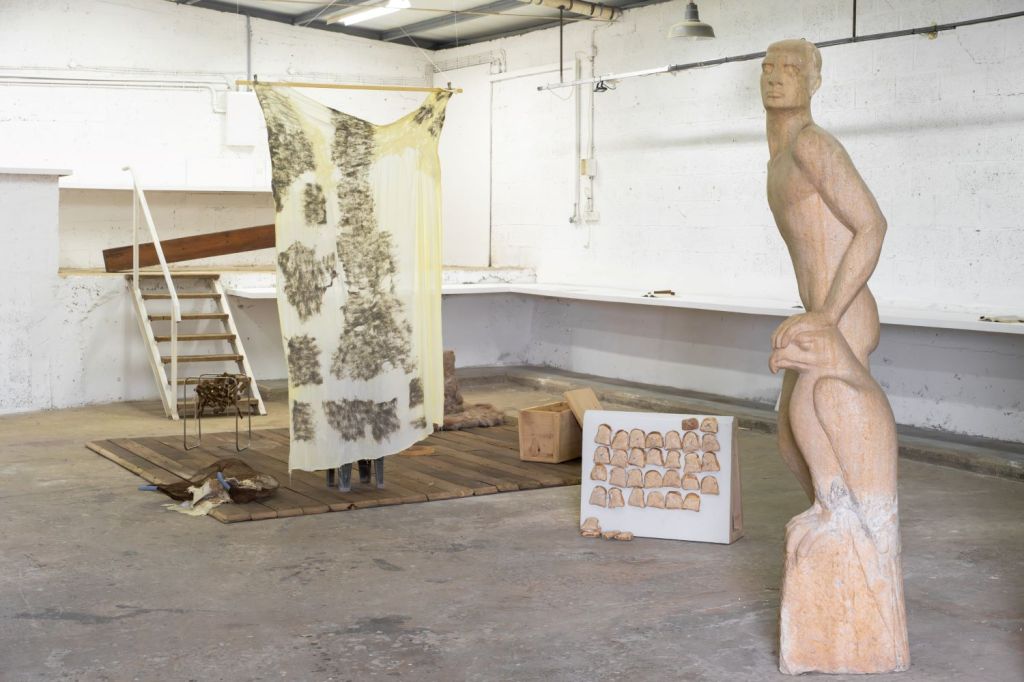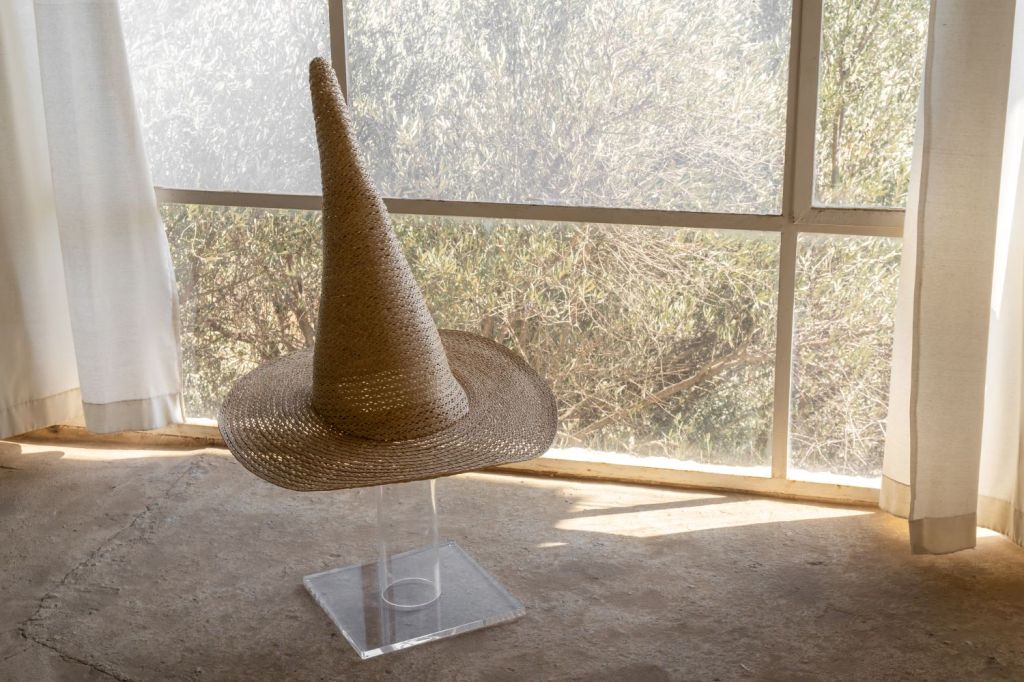Atelier Shemi, Kibbutz Cabri
Curator: Ronny Lao Koren
2 September 2023 – 21 October 2023
1.
The entrance to the exhibition Through the Back Door leads into the sculpture space of Atelier Shemi, where Yehiel Shemi crafted large-scaled sculptures made out of iron and wood. These works coexist alongside the remnants of the artist's personal life, preserved almost exactly as he left them. Among these artifacts, one can spot an antique radio, a plastic container bearing the name ‘Shemi,’ tools that still hang on the walls, and an array of intriguing stains and marks etched into the floor. Upon entering, visitors are greeted by Shemi's sculpture titled ‘Adam in the Arava’, created in 1951 and displayed for the first time at an exhibition in Kibbutz Na׳an. This sculpture portrays a nude male figure with one hand resting on an eagle, fashioned from the distinct yellowish limestone found in the desert. The desert landscape significantly influenced Shemi, particularly due to its intensity and aridity. Just behind Adam in the Arava, one encounters Glazer’s work, ‘Calendar’ (2023). This sculpture comprises 33 white bread replicas crafted from sika paste. Glazer's creative process involved coating dry white pan bread with sika paste, allowing it to dry before making "X"-shaped slits in the sika envelopes. Subsequently, these pieces were submerged in water until the bread completely dissolved, leaving behind a faint imprint on the sika shells. Later, she embedded magnets within these shells, allowing her to affix them to a geometric object resembling a folding sign, composed of metal and poplar wood. The juxtaposition of these two sculptures, one by Shemi and the other by Glazer, serves to define and distill the differences and similarities between the two artists and their approaches to sculpture. ‘Adam in the Arava’ evokes the pioneering spirit as the figure strides boldly forward, captivated by the wilderness. On the opposite end, Glazer's Calendar delves into the systems and tools devised to mark the cycles of nature, reflecting a need for control and comprehension. For Shemi, the desert symbolizes yearning and a sense of home, while for Glazer, it represents a boundless realm of imagination. To her, the desert appears as a menacing and boundless expanse. Nevertheless, both artists share a profound belief in the spiritual significance of the desert. Shemi's sculptures carry a commemorative essence, whereas Glazer's art arises from the premise that sculpture is inherently dynamic, both in the meanings it conveys and its physical attributes. Her creative process revolves around the temporality of materials, exploring how organic substances can decay, peel, and fade when exposed to the elements and the passage of time. Even though he occasionally incorporated recycled materials, such as parts from ships acquired from the port of Haifa, Shemi, on the other hand, crafted sculptures that exude stability and rigidity, often carved from stone or forged from metal.
2.
Shemi’s outdoor sculptures are exposed to the intense Israeli sunlight, creating a striking interplay of light and shadow upon his work. The relentless and unyielding nature of the Israeli sun plays a pivotal role. In the scorching summer months, the sun acts both as a protective shield and a deflective barrier for Shemi's outdoor pieces. Even within the studio space, his indoor works retain the fervent aura stemming from their monumental placements, adorned with visible signs of sun-induced wear and tear. In contrast, Glazer’s works engage with light as an elusive, pale, and almost ethereal element. She situates her works in enclosed spaces where incoming light gently filters through windows and openings. There is a Scandinavian tradition that revolves around the light escaping from homes during dusk hours. Scandinavians tend not to rush to switch on indoor lights but rather wait until daylight has completely faded. This practice may stem from their appreciation for the unique quality of subdued evening light and the mood it evokes. Additionally, the longer daylight hours in Scandinavian regions make nights relatively rare. This practice may also be associated with their commitment to conserving electricity, as the Scandinavian people are known for their frugality, irrespective of their income level or social status. Twilight zones and their gradual transformations are integral elements within the exhibition, almost assuming identities of their own. In her quest to prolong and reevaluate this phenomenon, Glazer infuses her impressions into the spaces of Atelier Shemi. Staying within the confines of the Atelier unveils a rich tapestry of both local and universal artistic history, further intensifying the enveloping impact of Glazer's works. They evoke memories, emotions, and physical experiences that resonate with our contemporary existence.
3.
Exiting the sculpture room, you proceed through Atelier Shemi's office. Inside this room, you encounter, near the back and close to the window, a straw witch hat integrated into the intimate and everyday workspace of the Atelier team. Moving onward, you reach the painting space, where the artworks are presented within a minimalist setting. At the center of the room stands a white platform, showcasing the piece ‘Twisted Untwisted’ (2023). This work consists of a white plastic bag adorned with affixed iron coils, intertwined with small balls of coconut coir. Two coils extend outward from the bag, entwining themselves around anchors securely fastened to the ceiling. The presence of fluorescent lamps and the sterile-looking isolation molds adorning the ceiling seems to draw inspiration from a clinical setting, complementing the contemplative nature of the works displayed in this space. Adjacent to the platform, a sheet of gray and silver sponge is affixed to the wall using adhesive tape, casting reflections of light throughout the room. Hanging from a tightly stretched cable is a plastic bag that holds sandpaper and a black-and-white print of 'Saturn Devouring His Son,’ a painting by Francisco Goya from 1818, sourced from an old reproduction book.
- Goya’s original painting was primarily a mural he made as part of the “black series”
- Books on display, from left to right:
- I Am Traveling A Great Distance, Monica Sok
- In Praise of Shadows, Jun’ichirō Tanizaki
- Pond, Claire-Louise Bennett
photo by Daniel Hanoch




















shemi@kabri.biz 15:00–11:00 שעות פתיחה: ב'–ה' ושבת
052-8840215 ; לפרטים נוספים: אטליה שמי, כברי 04-9952709
